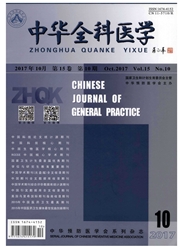

 中文摘要:
中文摘要:
目的 探讨慢性肾脏病(CKD)患者血硫酸吲哚酚浓度(IS)变化及与心血管疾病(CVD)相关指标的关系,为CKD患者合并CVD的防治提供临床参考。方法 ①112例CKD患者按K/DOQI指南分为CKD 3期、CKD 4期、CKD 5期组,正常对照组40例。②收集临床资料,高效液相色谱-荧光法检测IS浓度。③心脏超声检查左心室舒张末内径(LVDd),室间隔厚度(IVST),左心室后壁厚度(LVPTW),射血分数(EF),二尖瓣舒张晚期血流速度(A)与二尖瓣舒张早期血流速度(E)的比值(A/E)。④硫酸吲哚酚(IS)作因变量,CVD相关指标作自变量进行相关分析。结果 ①所有患者的生化指标和IS明显高于对照组。②对照组血IS为(0.08±0.06)μg/ml,CKD3/4/5期分别是(0.13±0.12)μg/ml、(0.48±0.53)μg/ml、(2.74±2.49)μg/ml,差异有统计学意义(P〈0.05)。③CKD患者的心脏结构及功能明显异常(P〈0.05),表现为室间隔、心室壁增厚和心室内径增大,A/E〉1,EF下降。④血IS与CVD相关指标(收缩压、舒张压、TC、TG、LDL-C、P、i PTH、IVST、LVPWT)呈明显正相关。结论CKD患者的IS随肾功能的下降而引起体内积聚;CKD患者合并CVD有心肌肥厚、心室收缩和舒张功能不全等表现;IS在CKD的心血管疾病发生发展中有相关作用。
 英文摘要:
英文摘要:
Objective To explore the relationship between serum indoxyl sulfate(IS) levels indices associated with cardi- ovascular disease (CVD) in patients with chronic kidney disease( CKD), and to provide clinical reference for the preven- tion of cardiovascular events in CKD patients. Methods Total 112 cases of CKD was recruited and divided into stage 3 group,stage 4 group and stage 5 group, and 40 normal subjects were assigned into the control group. The general clinical data were recorded. The serum 1S level was detected by high performance liquid chromatography. CVD indices such as LVDd, IVST, LVPTW, EF, A, E and A/E were measured by Color Doppler echocardiography. The relation between IS and CVD indices were analyzed statistically. Results The biochemical indices and the serum level of 1S of all patients in CKD groups were obviously higher than that of the control group. The serum level of IS was (0.08 ± 0.06) μg/ml in the control group,and (0.13 ±0.12) μg/ml, (0.48 ±0.53) μg/ml and (2.74 ±2.49) μg/ml(P 〈0.05) in CKD 3/4/5 groups ,respectively ;serum IS was increased with the decreased renal function( P 〈 0.05 ) ;the abnormal cardiac structure and function were shown in CKD patients, while interventricular septum and the ventricular wall were thicken and ventric- ular diameter were increased, the A/E 〉 1, the ejection fraction were declined, significantly positive correlation were detec- ted among serum 1S and CVD indexes ( systolic pressure, diastolic blood pressure, TC, TG, LDL-C, P, iPTH, IVST, LVP- WT). Conclusion IS can be accumulated in serum along with the decline of renal function in CKD patients;patients with CKD and CVD always has myocardial hypertrophy and ventricular systolic and diastolic dysfunction;IS may play an important role in the development of CVD in CKD patients.
 同期刊论文项目
同期刊论文项目
 同项目期刊论文
同项目期刊论文
 期刊信息
期刊信息
